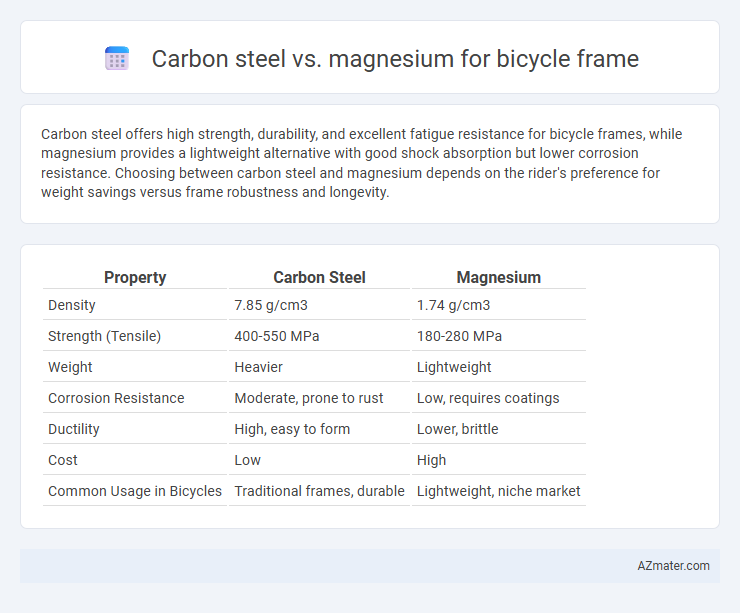Carbon steel offers high strength, durability, and excellent fatigue resistance for bicycle frames, while magnesium provides a lightweight alternative with good shock absorption but lower corrosion resistance. Choosing between carbon steel and magnesium depends on the rider's preference for weight savings versus frame robustness and longevity.
Table of Comparison
| Property | Carbon Steel | Magnesium |
|---|---|---|
| Density | 7.85 g/cm3 | 1.74 g/cm3 |
| Strength (Tensile) | 400-550 MPa | 180-280 MPa |
| Weight | Heavier | Lightweight |
| Corrosion Resistance | Moderate, prone to rust | Low, requires coatings |
| Ductility | High, easy to form | Lower, brittle |
| Cost | Low | High |
| Common Usage in Bicycles | Traditional frames, durable | Lightweight, niche market |
Introduction to Bicycle Frame Materials
Carbon steel offers excellent strength, durability, and repairability, making it a popular choice for traditional bicycle frames, while magnesium frames provide a lightweight alternative with good vibration damping and corrosion resistance. In terms of weight, magnesium frames are significantly lighter than carbon steel, contributing to enhanced ride agility and speed. Manufacturers often balance cost, performance, and rider preferences when selecting between carbon steel and magnesium for bicycle frame construction.
Overview of Carbon Steel in Bike Frames
Carbon steel is a traditional material for bicycle frames, offering excellent strength and durability at a relatively low cost. Its high tensile strength provides robustness and resistance to impact, making it suitable for a variety of riding conditions. While heavier than magnesium, carbon steel frames are favored for their longevity, ease of repair, and comfortable ride quality due to natural vibration damping properties.
Overview of Magnesium in Bike Frames
Magnesium bike frames are valued for their lightweight properties, offering a significant weight reduction compared to traditional carbon steel frames while maintaining adequate strength and durability. Magnesium's natural damping characteristics provide enhanced vibration absorption, resulting in a smoother ride over rough terrain. Although less common than carbon steel, magnesium frames are increasingly popular for high-performance and custom bicycles due to their unique balance of weight, strength, and ride quality.
Weight Comparison: Carbon Steel vs Magnesium
Magnesium bicycle frames are significantly lighter than carbon steel frames, typically weighing around 1.5 to 2 kilograms compared to carbon steel's 2.5 to 3.5 kilograms for similar-sized frames. The lower density of magnesium (1.74 g/cm3) compared to carbon steel (7.85 g/cm3) results in improved weight savings, enhancing overall bike performance and maneuverability. Despite magnesium's weight advantage, carbon steel offers greater strength and durability, which may influence material choice depending on riding style and frame design priorities.
Strength and Durability Differences
Carbon steel bicycle frames offer exceptional tensile strength and remarkable durability, making them highly resistant to fatigue and damage from regular use. Magnesium frames, while lighter and providing excellent shock absorption, generally have lower tensile strength and are more susceptible to corrosion and cracking under stress. The choice between carbon steel and magnesium depends on whether long-term strength and frame longevity or weight reduction and ride comfort are the primary concerns for cyclists.
Ride Quality and Comfort Analysis
Carbon steel bicycle frames offer exceptional ride quality due to their natural vibration-damping properties, providing a smooth and comfortable experience on varied terrains. Magnesium frames are lighter and provide a more responsive ride but can transmit more road vibrations, potentially compromising comfort over long distances. Riders seeking a balance of durability and comfort often prefer carbon steel, while those prioritizing lightweight performance may opt for magnesium despite a firmer ride quality.
Cost and Affordability Factors
Carbon steel bicycle frames typically offer greater affordability due to lower material and manufacturing costs compared to magnesium frames, making them a popular choice for budget-conscious cyclists. Magnesium frames, while more expensive, provide a lightweight alternative with enhanced corrosion resistance but involve higher production costs that drive up retail prices. Cost-sensitive buyers often prefer carbon steel frames as they balance durability and price, whereas magnesium frames cater to those willing to invest in advanced materials for performance gains.
Maintenance and Longevity
Carbon steel bicycle frames require regular maintenance to prevent rust and corrosion, especially when exposed to moisture, but they offer exceptional durability and can last decades with proper care. Magnesium frames are naturally corrosion-resistant, reducing the need for frequent upkeep, yet they may be prone to cracking under severe stress and sometimes have a shorter lifespan compared to steel. Choosing between the two depends on balancing the commitment to maintenance routines with the desired frame longevity and riding conditions.
Environmental Impact of Both Materials
Carbon steel bicycle frames generate higher greenhouse gas emissions during production due to energy-intensive mining and smelting processes, yet they offer excellent recyclability with established scrap steel recycling systems. Magnesium frames have a lower density, potentially reducing transportation emissions and improving fuel efficiency during shipping, but their production involves energy-heavy extraction and refining, often from less sustainably managed sources. Both materials present environmental trade-offs, with carbon steel favored for circular economy benefits and magnesium offering weight-saving advantages that may contribute to downstream emission reductions.
Choosing the Right Material for Your Riding Style
Carbon steel offers excellent durability, shock absorption, and a smooth ride, making it ideal for touring and commuter cyclists who prioritize comfort and longevity. Magnesium frames provide lightweight performance and enhanced agility, catering to competitive riders and mountain bikers seeking speed and maneuverability. Selecting between these materials hinges on balancing weight preferences, ride quality, and the specific demands of your riding style.

Infographic: Carbon steel vs Magnesium for Bicycle frame
 azmater.com
azmater.com